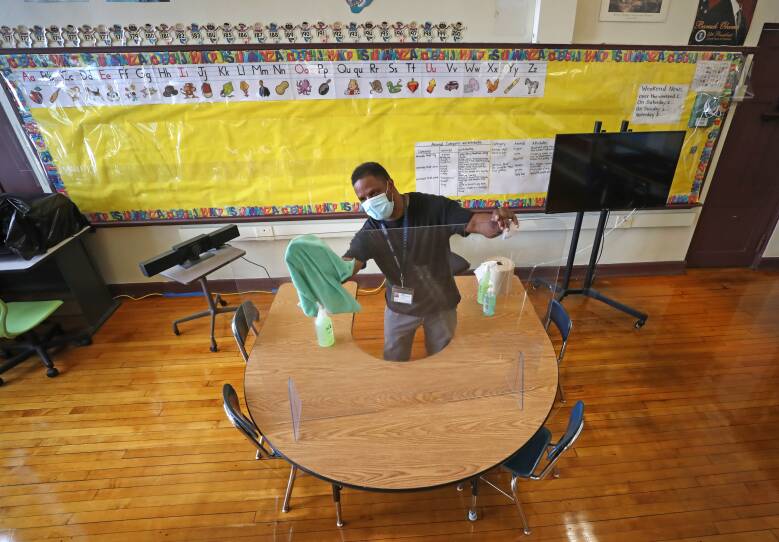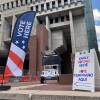Even before the pandemic erupted last spring, Boston’s aging schools faced a backlog of repairs and problems.
The average school is 80-years-old — older than schools in most communities across the state. The city acknowledged as much in a report called “BuildBPS” that found rooftops, windows and critical systems like ventilation were either severely inefficient or in need of outright replacement.
Throw the risk of a deadly airborne virus into the mix, and parents like Mary Pierce cringe at the thought of sending her fifth-grader into a classroom at the Boston Teachers Union School. Built 30 years before the other pandemic — in 1918 — Pierce is unsure whether the Jamaica Plain school even has a ventilation system.
“It’s extremely concerning,” she said. “It’s just not built for a pandemic.”
In Boston, that’s not unusual. A $1.6 million school facilities assessment for the city conducted by the architectural firm Symmes, Maino & McKee paints a grim picture of a worn out school buildings system. The Cambridge firm produced the in-depth report to lay the groundwork for Mayor Marty Walsh’s “BuildBPS” plan to modernize school buildings. Data from the report show that nearly three-quarters of the school facilities' ventilation distribution systems were either “functioning minimally,” in need of replacement or non-existent. So were more than half of the schools’ plumbing systems. The rating of schools’ toilet fixtures found that half needed to be replaced or were barely functioning.
“It should be noted,” the report said, “that much of what can be done to building systems that are past their useful life has already been done, and that the maintenance of such systems is likely a considerable burden to … budgets.”
Those persistent maintenance problems have frustrated parents and led teachers to protest unsafe working conditions in car caravans as the pandemic continues to upend normal life.
City officials have downplayed the findings with assurances that buildings can and will reopen safely in Boston, which is scheduled to happen Oct. 1.
Samuel DePina, chief of operations for BPS, called it a “snapshot” of city schools in 2016 and offered up a handful of air quality improvements at city schools. They included updating fans and motors at the Jackson/Mann K-8 School in Allston and the Josiah Quincy School in Chinatown, as well as HVAC overhauls at some schools. He would not say how many of the 127 schools underwent repairs, only that the HVAC systems of the 35 schools that have one are working.
“We're confident that the buildings will be fine,” DePina said in an interview with GBH News. “Since then, we've continued to maintain our systems and repair our systems as we need to.”
The district has also been identifying classrooms where windows were inoperable to make sure at least one per classroom could open to improve air flow.
“We only identified 291 that needed repairs to be able to open,” he said. “That was Phase 1 of the work, which will be done before school. We also identified 7,000 other windows that we’re going to repair.”
The fixes seem like a band aid on a broken limb to some parents, and teachers unions have led protests at the State House because they say they feel unsafe in conditions widely acknowledged as outdated.
According to the BuildBPS report, about half of the district’s physical buildings were rated as fair or lower in condition. Three schools were rated “poor,” and 12 of 131 were rated “excellent.” (Ten were not assessed.) More than half of the city’s schools were built before World War II, including eight built in the late 1800s.
“We’re confident that kids will be safe,” DePina said. “Are they brand new systems that everyone may be looking for? No, but I think we do a good job and maintain the systems we have.”

That’s a tough sell to Trevour Smith, a math teacher at the Boston Latin School who favors all-remote learning. He says the poor ventilation in the school combined with his concern for older colleagues who are in their sixties and more susceptible to the virus, have made him wary to return to the classroom.
In April, his grandfather died from COVID-19, and he fears that the school could face a similar loss.
“They need to fund us fully, to come in and outfit us fully with HVAC systems and give us the proper PPE protection,” he said of city leaders. “They haven’t said [they will do] any of those things. They haven’t done any of those things.”
Last week — after Smith was interviewed — the district agreed to offer teachers PPE upon request, in addition to two reusable face masks.
DePina said he doesn’t know what the cost would be to replace or repair ventilation systems systemwide. According to BuildBPS, many elementary school classrooms were designed with gravity ventilation systems that include exhaust grilles connected to rooftop ducts with wind-driven turbine vents. Over the years, most have been blocked off to save energy and reduce heat loss.
The status of those systems is under review. District officials say HVAC teams and their contractors have been conducting maintenance and repair inspections and necessary work. Under a new agreement reached by district leaders and the Boston Teachers Union, all worksites are to be independently evaluated within one month of the staff's and students' return, and that data — including air quality tests — will be made publicly available on the BPS website.
Officials must also consider the unknown risks that come with aging schools that have been left dormant for the last six months. Schools in Ohio and Pennsylvania were shut down suddenly after outbreaks of Legionella, a bacteria that grows in stagnant water and can cause deadly pneumonia.
DePina says the BPS’ plumbing division has flushed the system to prevent the spread of bacteria and inspected every one of the system’s 202,200 bathrooms in preparation for students’ return, making sure there is running water, including hot water, in every bathroom. The district has also repaired about 300 faucets in recent weeks and 120 toilet flushing mechanisms, he said.
In many cases, simply opening a window can offer enough ventilation to disperse the virus, says Joseph G. Allen, director of the Healthy Buildings Program at Harvard’s Chan School of Public Health. Allen is the primary author of a new report on strategies for reducing risk when reopening schools that has found a national audience.
“There is a massive cost to keeping kids out of school,” Allen said. “And it’s unlikely we will have time to fix all the mechanical ventilation systems, but there are things you can do.”
Functioning bathrooms that allow for student hygiene is key, he said. Among the recommendations is installing toilets lids to prevent airborne virus transmission. Portable air filtration systems are another relatively inexpensive way to address poor air quality in classrooms.
Those could be an especially attractive option for schools where pollution levels were already high pre-pandemic. In East Boston, in the shadow of Logan Airport, air quality and elevated asthma rates among students have been a problem for years.
Yet only four of the 10 city schools in East Boston have fully-functional ventilation systems, according to BuildBPS data. Making matters worse, East Boston has the highest positive test rate in the city for COVID-19.
Like Mary Pierce in Jamaica Plain, Lilliana Arteaga joined the environmental activist group Mothers Out Front in East Boston before the pandemic because of concerns about her seven-year-old son’s frequent respiratory infections. She's been part of the ongoing debate about whether classrooms there should use box fans to circulate air at his school, the Dante Alighieri Montessori School.
Recently diagnosed with mysterious nodules on her own lungs, Arteaga says that while fans can carry fresh air they may also circulate the virus, raising concerns that stop-gap measures may have unintended consequences. It’s just one of many uneasy considerations around sending her son back to school this year or keeping him home.
“It’s a big decision,” she said. “As a parent, I’m concerned.”
And that’s whether the windows are open or closed.
Correction: This article has been updated to correct the spelling of Samuel DePina's last name. It is DePina, not DiPena.




